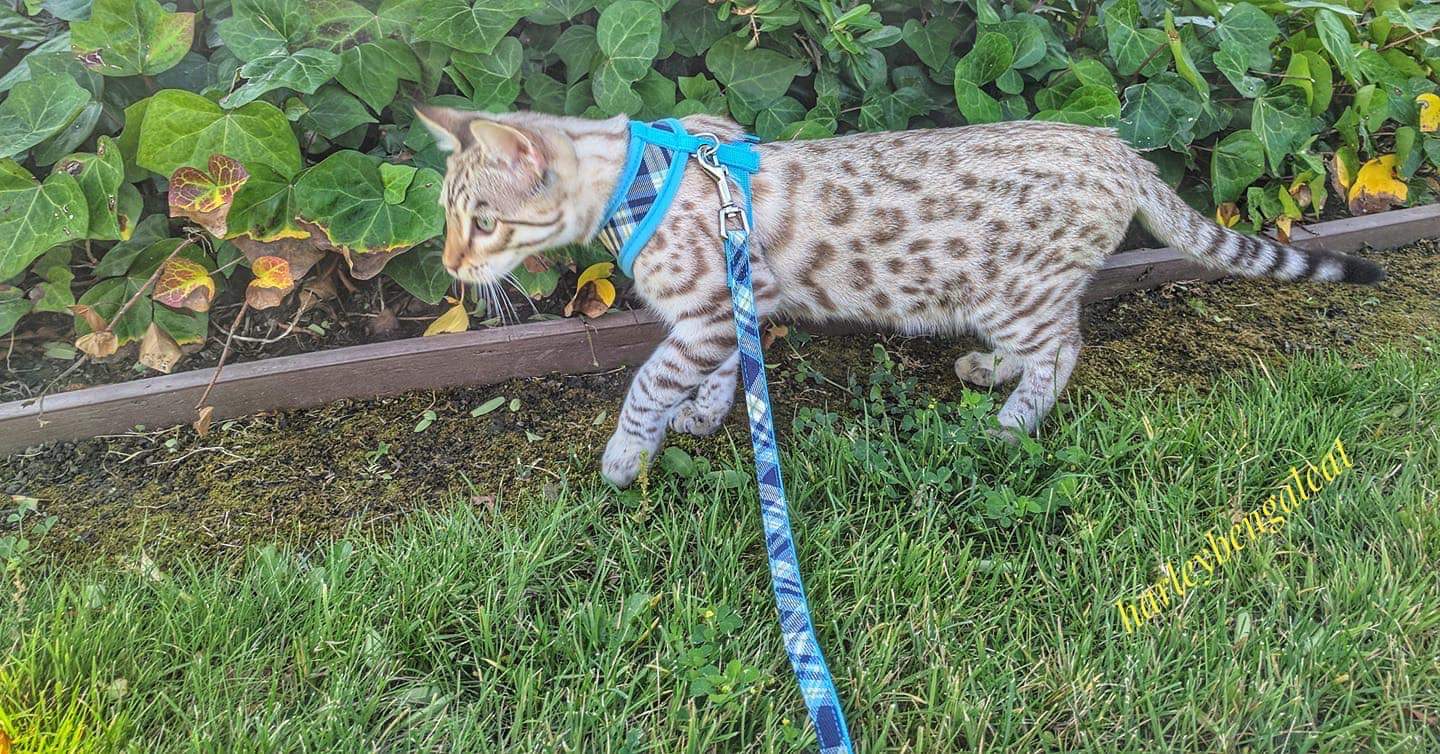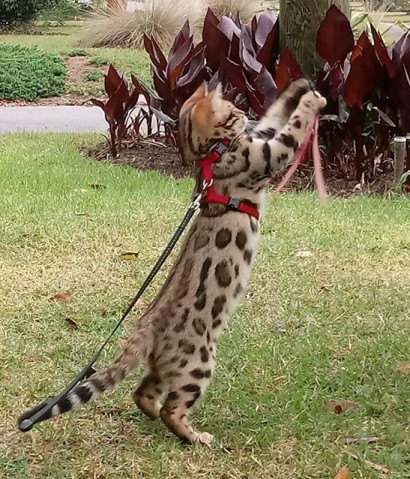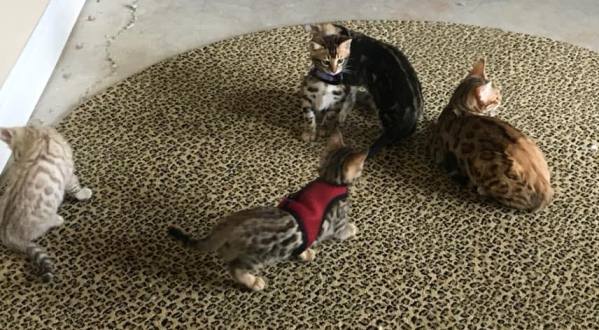
Everyone knows that dogs should be walked, but cats? Anyone who’s had the experience of a cat freaking out in the car, bursting out of their carrier, and hiding under the brake pedal may not think it such a great idea. Cats don’t like to go out of their comfort zone, right?
Believe it or not, many cats can be taught to walk on a leash and love it. Going outside stimulates a cat’s mind and body, and being on a leash keeps the situation safe and under control. The keys are knowing your cat, selecting the right equipment, and proper preparation and training.

There is a lot of controversy about letting cats outside. Although it is good for them in many ways, there are an equal number of risks in unsupervised outside access. Leash walking is an alternative that can be both safe and enjoyable. This has become such a good option in the city that the San Francisco SPCA even teaches it in their kitten kindergarten!
Is your cat a good candidate?
Is your cat the outgoing, social type? Is he the center of attention, running to greet you as soon as you get home? What does he do when you have company? Does he come out to meet them, looking for pets? What is his history? Has he been indoors all his life, or did he have outdoor access before? Is he curious and interested in the outside world, looking out the window? If you answered yes, your kitty may be a good candidate for leash walking.
Is your cat shy and unsocial? Does he hide under the bed, only coming out when it is very quiet or at night? Is he fractious or doesn’t like to be handled? You see where I’m going with this – the shy or fearful cat is probably not a great candidate for leash walking. However, these are generalizations. You know your cat best, and if you proceed carefully and with some planning, many cats can become accustomed to leash walking.

Years ago I had an amazing cat named Skyway, so named because she was found as a newborn on an airstrip. Her former owner, who worked at the airport, hid her in a file drawer and nursed her every couple of hours. Skyway grew into a healthy loving cat, somewhat resembling a soccer ball as she was black, white, and round. Skyway came into my life just as I was starting my pet sitting business, and when I had the opportunity to do a free professional photo shoot, I took her along. I must not have secured the cat carrier because as I was speeding along on the 101 freeway, the door opened and out she came! Instead of freaking out, she stretched out on the passenger seat and soaked up the sun. All the way to the photo shoot other drivers smiled and waved. At the photo shoot, Skyway sat wherever I put her and was calm as can be. She would have been a good candidate for leash walking, and for Instagram had it existed in the 90’s!
Gear up
As with dogs, you want to use high-quality and properly fitted equipment for walking. If you’ve ever seen one of those clips of cats on live TV where they go berserk, you’ll appreciate the need for good equipment! You don’t want your kitty freaking out and biting you, or taking off and getting lost or trapped somewhere. Don’t just buy whichever harness is available at your local pet store. Shop around, compare, and check reviews. You may need to purchase several before you find a good fit that is both comfortable and secure. Do not walk a cat on a collar. Their anatomy is different from a dog’s, and with their loose skin they can easily slip out of a collar. If the collar is tight, they can hang themselves if they become frightened and get caught on something.

Leash training
Cat training is a relatively new concept in the mainstream. In the past, the only cats that were trained were those used in show business, like Siamese Syn, star of That Darn Cat and The Incredible Journey, and the iconic orange tabby Morris. Since punishment doesn’t really work with cats, they were some of the original recipients of positive reinforcement techniques. Trainers used treats and lures to cue them to jump up or down, walk one way or another, meow, etc. Today thanks to popular cat behaviorists like Jackson Galaxy, cat training is seen as something beneficial that anyone can do in their home. Using toys, treats, and in some cases a clicker, cats can be trained to go into a carrier, receive medication, come when called, and many other useful behaviors behaviors. Some animal shelters like the City of Tallahassee Animal Service Center are using training as way to relieve cats’ stress and to increase their chances of adoption.

Wild Legacy Bengals in Florida trains all of their kittens to a harness and leash before they go to their new homes. Bengals need exercise and stimulation, but should not be left to roam outside unsupervised. Says owner Rommey, “We put the harness on and let them be, distract them with food, play with a feather wand, but most importantly, act normal yourself. “ Some kittens flop around and try to get the harness off while others lie still. As soon as they get up and walk around a bit, the harness is removed. This is repeated daily until the kitten no longer notices the harness. “Once they no longer act like anything is wrong, attach the leash and wait them to start dragging it. Once they start dragging it, apply a little back pressure. Some will react all over again, but most don’t. They eventually love it and enjoy it!”

Safe walking
A couple years ago I received a call from a frantic woman who had lost her cat. For reasons unknown to me, she and her daughter had decided to take their cat to the park, like a dog. They loaded him up in the car, drove to the city park, and let him out … where he promptly bolted and hid in the bushes. After hours of searching, they gave up and went home. I counseled her over the phone and connected her with pet rescue folks in the area, but I don’t think she ever found her cat. I felt bad for her because she meant well, but just had no clue about cats.
The best place to start walking is very close to your house. Ideally, you open the door and walk out, leaving the door open, the idea being if your cat gets startled, he will run back in the door instead of out in the street. Of course this will only work if it’s safe to leave the door open, and there are no other pets in the room who might bolt out. Take it slow and let him explore. Cats don’t take well to marching off down the road like you would do with a dog. Stay in the safety zone and go a little farther each time, paying close attention to your surroundings. Avoid dogs, even if they are on leash. Many dogs have predatory tendencies, and can easily injure or even kill a cat. Even a friendly dog can frighten a cat with his exuberance and interest in making friends.
I hope this is helpful in getting you started training your cat. Please comment if you are in the process or if your kitty is a seasoned leash walker.


Be the first to comment